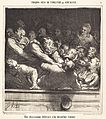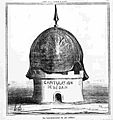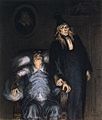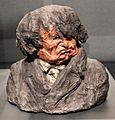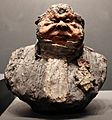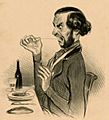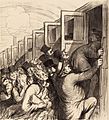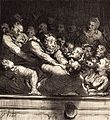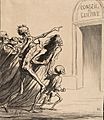Honoré Daumier facts for kids
Quick facts for kids
Honoré Daumier
|
|
|---|---|

Honoré Daumier circa 1850
|
|
| Born |
Honoré Victorin Daumier
February 26, 1808 |
| Died | February 10, 1879 (aged 70) Valmondois
|
| Nationality | French |
| Known for | Printmaking, painting, sculpture |
Honoré-Victorin Daumier (February 26, 1808 – February 10, 1879) was a French artist. He was a printmaker, caricaturist, painter, and sculptor. His many artworks show what social and political life was like in France during the 1800s.
Daumier created over 500 paintings, 4000 lithographs, 1000 wood engravings, 1000 drawings, and 100 sculptures. He was especially known for his caricatures of political leaders. He also made fun of how people behaved in his home country. After he died, his paintings became very famous too.
Contents
Daumier's Life Story
Daumier was born in Marseille, France. His parents were Jean-Baptiste Louis Daumier and Cécile Catherine Philippe. His father was a glazier (someone who installs glass). He wanted to be a poet, so he moved to Paris in 1814. Young Daumier and his mother joined him in Paris in 1816.
From a young age, Daumier loved art. His father tried to make him work in other jobs. First, he was an errand boy for a bailiff (a legal officer). Then, he worked for a bookseller. But Daumier always wanted to be an artist.
In 1822, he started learning from Alexandre Lenoir. Lenoir was an artist and an archaeologist. The next year, Daumier joined the Académie Suisse, an art school. He also worked for a lithographer (someone who makes prints) and publisher. This is where he first tried making lithographs.
After learning how to make lithographs, Daumier started his art career. He made prints for music companies and pictures for advertisements. He also did some anonymous work for publishers. He copied the style of another artist, Nicolas Toussaint Charlet. Daumier was very interested in the stories of Napoleon.
After the French Revolution of 1830, Daumier began making art about his political ideas. By 1873, he was almost blind.
During the time of King Louis Philippe, a comic newspaper called La Caricature was started by Charles Philipon. Daumier joined the team of artists there. He began drawing funny pictures to make fun of society. He targeted the habits of the middle class, unfair laws, and a clumsy government.
His drawing of the king as a giant character called Gargantua led to Daumier being jailed for six months in 1832. Soon after, La Caricature stopped being published. But Philipon started a new newspaper called Le Charivari. This gave Daumier a new place to share his art.
Daumier made many social caricatures for Le Charivari. He often made fun of middle-class society using a character named Robert Macaire. This character was from a popular play. In another series, L'histoire ancienne, he made fun of the old-fashioned art styles of the time. Daumier left Le Charivari in 1863 but rejoined in 1864.
Around the mid-1840s, Daumier started publishing his famous caricatures of people in the legal system. These were called 'Les Gens de Justice'. They were funny but sharp pictures about judges, lawyers, and people in court. Some say Daumier's own experience working in a bailiff's office when he was young made him feel this way about lawyers.
In 1834, he made a lithograph called Rue Transnonain, 15 April 1834. This artwork showed a terrible event where many people were killed in Paris. It was made to support freedom of the press. It also helped pay for legal costs against Le Charivari. The police found the print and took it, along with the stone used to make it. The prints we see today are the ones that survived.
Daumier's Sculptures
Daumier was not only a great printmaker and painter, but he also made many sculptures. He often used unbaked clay for these. To save these special artworks, some were first copied in plaster. Later, bronze sculptures were made from these plaster copies after Daumier had died.
Daumier made about 36 busts (head and shoulders sculptures) of French members of Parliament. These were originally in unbaked clay. Later, bronze versions were made from plaster copies. These bronze busts were made after his death. The original clay sculptures, which have been repaired, can be seen at the Musée d'Orsay in Paris.
Some small baked clay figures, called 'Figurines', appeared in the 1950s. It is not certain if Daumier made all of these himself. Some experts believe they might have been made by others who copied his style.
However, there is no doubt that Daumier made the sculptures called Ratapoil and Emigrants. His bronze self-portrait and a bust of King Louis XIV are also generally accepted as his original works.
Daumier often made small figures that he then used as models for his paintings. One of his most famous figures is called The Heavy Burden. It shows a woman and her child. The woman is carrying something heavy, maybe a large bag. This figure is about 14 inches tall.
Daumier made several paintings of The Heavy Burden. The woman and child look like they are being pushed by the wind. Daumier used this to show the bigger problems they were fighting against. These problems included the Revolution, the government, and poverty. In the painting, the woman and child are surrounded by a very dark shadow.
Daumier's Paintings
Besides his many caricatures (he made almost 4,000 lithographs), Daumier also painted. His paintings show a deep truthfulness and strong brushwork. It might be hard to believe the same artist who made funny caricatures also painted serious works. These include Christ and His Apostles (in the Rijksmuseum in Amsterdam) and Don Quixote and Sancho Panza.
As a painter, Daumier was one of the first to show everyday, realistic subjects. He often painted in a way that criticized differences between social classes. His paintings did not become popular until 1878, just a year before he died. A art dealer named Paul Durand-Ruel collected his works for an exhibition. This show proved how talented Daumier was. He was even called the "Michelangelo of caricature."
At the time of the exhibition, Daumier was blind. He was living in a small house in Valmondois. Another artist, Jean-Baptiste-Camille Corot, had let him use the house. Daumier died there.
Daumier's Legacy
The famous writer Charles Baudelaire said about Daumier: "One of the most important men, not only, I would say, in caricature, but also in modern art." This shows how important Daumier was.
An exhibition of his artworks was held in 1901 at the École des Beaux-Arts.
Daumier's works can be found in many of the world's best art museums. These include the Louvre, the Metropolitan Museum of Art, and the Rijksmuseum. He is famous for many works, including hundreds of paintings and drawings. Many of these show scenes from the story of Don Quixote. This story fascinated him for the last part of his life.
Daumier's 200th birthday was celebrated in 2008. There were many exhibitions of his art in Asia, America, Australia, and Europe.
Gallery
-
"NADAR élevant la Photographie à la hauteur de l'Art" (NADAR elevating Photography to Art).
-
Les Joueurs d'échecs (The chess players), 1863.
Realist painting, oil on canvas, 1863 (Petit Palais) -
The Laundress Oil on panel, c.1863 (Musée D'Orsay)
-
Don Quixote and Sancho Panza, 1868
Images for kids
See also
 In Spanish: Honoré Daumier para niños
In Spanish: Honoré Daumier para niños













